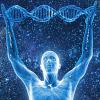I would think that as the yamanaka factors, or 4F, were discovered by looking at the chemical forces at play in the environment of reproductive cells such as embryos, that this would not be a problem. Whatever epigenetics you inherited would very likely be spared. There might be some small exceptions as a whole organism is much more complicated compared to an embryo, but I imagine that even if disrupted, whatever it was that lead to to those changes would restore them. Homeostasis being what it is, is this time, to our benefit.
YOLF, I think you might be right about inherited DNA methylation patterns being spared as can be seen from my last post. So far not much has been published to support this idea but I found a study supporting your statement.
As you point out the Yamanaka factors were born from reproductive studies but taking this approach with an adult organism has its risks. Studies like; "Repression of the Heat Shock Response Is a Programmed Event at the Onset of Reproduction" suggest once maturity is reached an over-arching epigenetic regulator is switched off, causing what we see as aging. A simple idea for a large cascade of epigenetic changes.
So as we look to what might be "lost" in the In Vivo Amelioration of Age-Associated Hallmarks by Partial Reprogramming process it "appears" some of our fears might be asswaged by this study as the original DNAm pattern survives in an immature version of the adult counterpart. This seems to be the only study to ask these questions.
"5. Impact of Reprogramming-Associated Alterations in the Study of Age-Related Diseases
The application of the analysis of DNAm pattern in iPSCs and their derivatives indicate that while reprogramming is associated with a reversion of DNAm patterns to embryonic-like state, the differentiation process does not lead to a full re-establishment of the cellular specific DNAm-profile. These results fit with what emerges from recent reports, indicating that tissues differentiated from iPSCs do not present the same physiological and functional features of the target cells rather than they are more similar to an immature version of their adult counterpart (Figure 2) [70,71]."
As always JMHO
Bryan
To the Group,
As I filter my search for studies trying to identify key epigenetic regulators I'm continuously struck with research on Extracellular Vesicles. Not long ago Extracellular Vesicles (EV's) were once thought to be just cellular debris, "junk," but no longer. It appears thru EV's certain epigenetic promotors are down-regulated and other pro-inflammatory regulators are up-regulated over time. In study after study, these epigenetic indicators can be tied to changes in the amount and kinds of Extracellular Vesicles released by cells. Coding efforts of these EV's specifically translates to up and down regulators of genes.
We would all like to see a master regulator (one target) at work and keep it simple. I'd like to believe it could be this easy, but the evidence is suggesting a large interrelated web of epigenetic feedback loops. So where to focus, which key genes need to stay active to save off cellular decline? I think this research is well underway by tracking Extracellular Vesicles and the cargo they carry. See: Aging affects extracellular RNA and extracellular vesicles. This is a 42-minute video showing ongoing NIH data collection on EV's and DNAm patterns.
"Nicole Noren Hooten from the National Institute on Aging at NIH contributes basic science research to the Healthy Aging in Neighborhoods of Diversity across the Life Span (HANDLS) project, a long-term study of health disparities and aging in Baltimore, MD.
This web seminar was presented as part of the Extracellular RNA Communication Consortium (ERCC) seminar series on September 7th, 2017."
We've spoken about epigenetic targets, and in reality, we are searching for one or more needles in a haystack. Along this path, amazing insights are being drawn about disease states and changes in the EV's being delivered to the affected tissues. We've discussed vectors in general and EV's have been the conserved method our bodies developed to reach the most inaccessible places. Here is one such example; Extracellular vesicles: mediators and biomarkers of pathology along CNS barriers.
So in this effort, cell to cell communications thru EV's plays an important indicator as to whats going on. I think following the bouncing ball by profiling aging individuals thru time will lead to a manageable number of key genes that "need" to stay active but are later down regulated. To this, I believe custom Extracellular RNA's can be written to stroke and keep them active as aging treatments, key epigenetic regulators that will save off the changes to the genes that later become active with aging.
#1 So as we look for a practical way to roll back the clock, #2 and since we don't have an OSKM polycistronic expression cassette installed in each cell of our bodies, we need vast numbers of researchers to uncover the mechanisms of disease and from this the upstream promotors of those states. This is pointing us deeper into the epigenome and Extracellular Vesicles as the vehicle of change and how we might encourage DNA methylation stability of key targets.
I hope I'm keeping the concepts global with ubiquitous examples. As you look at the success of the "In Vivo Amelioration of Age-Associated Hallmarks by Partial Reprogramming" project, it looks simple enough but, I don't think a single one of us would take this precise path. Also for me, I don't want to have to make permanent changes to my DNA through CRISPR or a retrovirus. Nature already gives us many conserved delivery paths to take and EV's are already there filling that role. So I hope that we will learn how to "play the instrument," rather than re-engineer the machine by blunt force.
As always JMHO
Bryan
Edited by Bryan_S, 31 July 2018 - 06:45 PM.























































